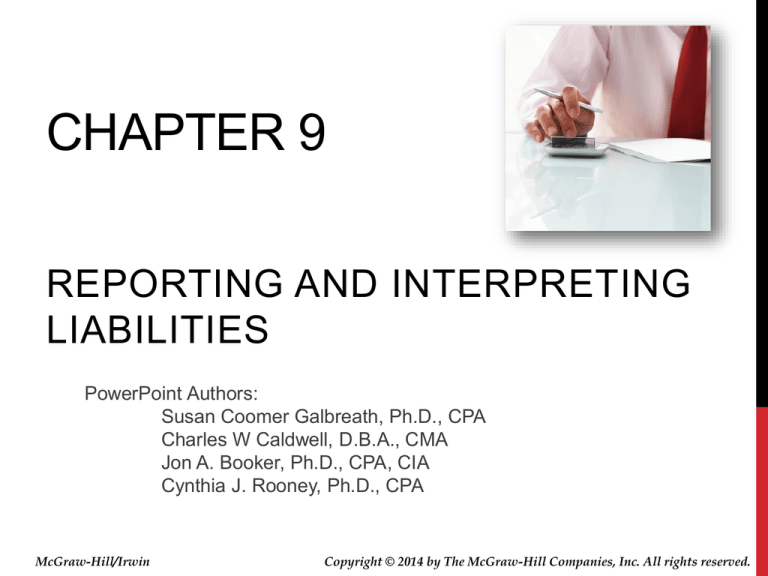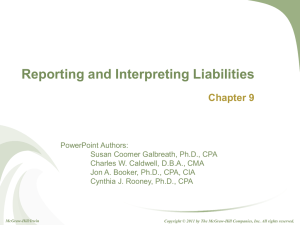
CHAPTER 9
REPORTING AND INTERPRETING
LIABILITIES
PowerPoint Authors:
Susan Coomer Galbreath, Ph.D., CPA
Charles W Caldwell, D.B.A., CMA
Jon A. Booker, Ph.D., CPA, CIA
Cynthia J. Rooney, Ph.D., CPA
McGraw-Hill/Irwin
Copyright © 2014 by The McGraw-Hill Companies, Inc. All rights reserved.
LIABILITIES DEFINED AND
CLASSIFIED
Defined as probable debts or obligations of the
entity that result from past transactions, which will
be paid with assets or services.
Maturity = 1 year or less
Maturity > 1 year
Current
Liabilities
Noncurrent
Liabilities
9-2
LIQUIDITY
Liquidity is the ability to pay current
obligations.
Working Capital
Current Assets
– Current Liabilities
Working capital is a
margin of safety
that ensures a
company can meet
its short-term
obligations.
9-3
CURRENT LIABILITIES
Account
Name
Accounts
Payable
Also
Called
Trade
Accounts
Payable
Accrued
Liabilities
Accrued
Expenses
Notes
Payable
N/A
Deferred
Revenues
Unearned
Revenues
Definition
Obligations to pay for goods and
services used in the basic operating
activities of the business.
Obligations related to expenses that
have been incurred but have not been
paid at the end of the accounting
period.
Obligations due supported by a formal
written contract.
Obligations arising when cash is
received prior to the related revenue
being earned.
9-4
PAYROLL TAXES
Gross Pay
Net Pay
Less Deductions:
Social
Security
Tax
Medicare
Tax
Federal
Income Tax
State and
Local Income
Taxes
Voluntary
Deductions
9-5
NOTES PAYABLE
A note payable specifies an annual interest
rate associated with the borrowing.
To
the lender, interest is a revenue.
To the borrower, interest is an expense.
Interest = Principal × Interest Rate × Time
When computing interest for one year, “Time”
equals 1. When the computation period is less
than one year, then “Time” is a fraction.
9-6
DEFERRED REVENUES
Revenues that have been collected but not
earned.
Deferred revenues are reported as a liability because cash has
been collected but the related revenue has not been earned by
the end of the accounting period.
9-7
ESTIMATED LIABILITIES
Contingent liabilities are potential liabilities that are
created as a result of a past event.
Subject to estimate
Not subject to estimate
Probable
Record as liability
Disclose in note
Reasonably Possible
Remote
Disclose in note
Disclosure not required
Disclose in note
Disclosure not required
The probabilities of occurrence are defined in the following manner:
1. Probable—the chance that the future event or events will
occur is high.
2. Reasonably possible—the chance that the future event or
events will occur is more than remote but less than likely.
3. Remote—the chance that the future event or events will
occur is slight.
9-8
WORKING CAPITAL MANAGEMENT
Working Capital = Current Assets – Current Liabilities
Changes in working capital
accounts are important to
managers and analysts
because they have a direct
impact on cash flows from
operating activities reported
on the statement of cash
flows.
9-9
LONG-TERM NOTES PAYABLE AND
BONDS
Relatively small debt
needs can be filled from
single sources.
Banks
Insurance
Companies
Pension
Plans
9-10
LEASE LIABILITIES
Operating Lease
Capital
Lease
Short-term lease; No
liability or asset
recorded
Long-term lease; Meets
one of 4 criteria; Results
in recording an asset
and a liability
Capital Lease Criteria
1. Lease term is 75% or more of the asset’s expected economic life.
2. Ownership of the asset is transferred to the lessee at the end of the lease.
3. Lease permits lessee to purchase the asset at a price that is lower than its
fair market value.
4. The present value of the lease payments is 90% or more of the fair market
value of the asset when the lease is signed.
9-11
PRESENT VALUE CONCEPTS
$1,000
invested
today at 10%.
In 1 year it
will be worth
$1,100.
In 5 years it
will be worth
$1,610!
Money can grow over time because it
can earn interest.
9-12
PRESENT VALUE CONCEPTS
The growth is a mathematical function
of four variables:
1. The value today (present value).
2. The value in the future (future
value).
3. The interest rate.
4. The time period.
9-13
PRESENT VALUE OF A SINGLE
AMOUNT
The present value of a single amount is
the worth to you today of receiving that
amount some time in the future.
Present
Value
Future
Value
Interest compounding periods
Today
Future
9-14
PRESENT VALUES OF AN ANNUITY
An annuity is a series of
consecutive equal periodic
payments.
Today
9-15
PRESENT VALUES OF AN ANNUITY
What is the value today of a series of
payments to be received or paid out in
the future?
Payment 1
Present
Value
Payment 2
Payment 3
Interest compounding periods
Today
9-16
SUPPLEMENT A: PRESENT VALUE
COMPUTATIONS USING EXCEL
Present Value of A Single Amount Formula
= Payment/(1 + i)^n
Present Value of An Annuity Formula
Use the present value of an annuity formula
programmed in Excel by selecting the
function button (fx ). In the drop down
menu, under the Select Category heading,
pick "Financial" and scroll down under
Select Function and click on "PV." In the
new drop down box, enter the specific
information for your problem and click
"OK."
9-17
SUPPLEMENT B: DEFERRED TAXES
Deferred Taxes
Exist because of timing differences
caused by reporting revenues and
expenses according to GAAP on a
company’s income statement and
according to the Internal Revenue
Code on the tax return.
Temporary
Differences
Timing differences that cause
deferred income taxes and will
reverse, or turn around, in the
future.
9-18
SUPPLEMENT C: FUTURE VALUE
CONCEPTS
Future value is the sum to which an amount will
increase as the result of compound interest.
How much will an amount today be worth in the future?
Present
Value
Today
Interest compounding periods
Future
Value
9-19
FUTURE VALUE OF AN ANNUITY
Equal payments are made each period.
The payments and interest accumulate over time.
Payment 1
Payment 2
Payment 3
Interest compounding periods
Today
9-20
END OF CHAPTER 9
9-21




